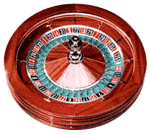

One of the most comical pass-times is to sit and watch people bet on the roulette wheel. Each person has their own system of placing bets. Some bet on their lucky numbers, others on anniversary dates and/or birth dates, etc.
I was once sitting at a roulette table placing a few outside bets (even-money and 2-to-1 bets) while working on testing and refining my own system (that you'll learn about under Winning Systems). I kept having to fight for room from this lady sitting beside me. Once the
betting period was opened, she'd commence stacking chips (8-12 per stack) at seemingly random numbers all over the table. She'd
continue until she had placed a stack on all 38 numbers! By the time her arms stopped flying from all the
bet placing, I barely had time to place a chip or two on red or black or odd or even, or whatever I was betting on at the time. After
several rounds of this, since she was dramatically dropping the number of spins per hour (I was also doing some
wheel-clocking and wanted as many spins per hour as possible), I asked the lady what she was doing. To this, she replied "winning". I said "really, how do you know you're winning". She said that since she was betting
on all the numbers, she couldn't lose. She said that if she happened to put more chips on the winning number, she'd win even more that round. I then asked her if she knew what the payoff was on straight-up bets (bets on single numbers). She
wasn't sure, but she said that it must be a lot because of the stack of chips she still had and from the pile of chips she'd receive as payoff on each round. I didn't have the heart to tell her that straight-up bets only pay 35-to-1 and since there are 38 numbers, she was losing even though she was "winning". Maybe
I should have told her, as it could have saved her a lot of money and possibly keep from boring everyone at the table to death while waiting for her to finish piling chips on so the croupier (person operating the roulette wheel) could spin the ball.
This brings me to my first point. And that is when you win, you still lose. Because the house only pays 35:1 instead of 37:1, the house maintains a constant 5.26% advantage over you, which gradually eats away your money until you have
none left. So with this being the case, is there no way to beat roulette and actually win money consistently? According to Einstein, the answer is "no". Was he correct? Or did he miss something?
If you've never played roulette or are unfamiliar with how the game is played, keep reading. Otherwise, go to Winning Systems and learn how to play roulette to win.
There are basically two different roulette wheel layouts: The American Wheel and The French Wheel. There are essentially only two differences between the two. The French (or European) wheel only has one "zero" (also known as a single zero wheel). Whereas the American wheel
has two "zeros" (also known as a double-zero wheel). The other difference is that the number sequence on the wheels are different -- done to balance the numbers when adding or removing a zero. Since this site is an American-Based site, we will stick only to the American wheel in our analysis. However, it should
be noted that everything mentioned here about the American wheel can be transformed with little difficulty to the French wheel. And actually, in many cases it is better to play the French wheel because of the single zero. With the single zero, the French wheel only has a 2.63% house
advantage instead of the 5.26% that the American wheel has. Therefore, a smart gambler would seek to find a single zero wheel and play it instead of the double-zero American wheel. Supposedly there are still some places in the US that have single-zero wheels around and from time-to-time
bring them out for use. Though I personally have never seen one here in the states.
On the internet, however, there are a number of online casinos that use the single-zero French style wheel and can be played from within the US. Though I am not sure how "safe" such online casinos
are. And I don't mean safe from internet money exchange. I mean safe from being cheated. With electronics, there are an infinite number of possible ways of being cheated. At least in a real casino, even though a table/wheel can be gaffed, at least you can look and see if it is or at least make sure the overall gambling process is being handled correctly. Whereas on
the computer, unless you are a very keen hacker, you have no way of knowing. Therefore, I can only recommend using online casinos in the "for-fun" method of play. With the for-fun mode, you can place would-be bets and test and try different systems of gambling without actually losing
real money. It is a good way to generate roulette numbers. However, if it is a true random system, it will lack the mechanical qualities of a real wheel and will prevent you from testing systems such as wheel-bias and wheel-clocking.
Here is a top view of an American wheel so you can get a feel for the layout of numbers. I must apologize for the blurriness of this picture, as it is an enlargement of a smaller picture. It was enlarged so that the numbers are more readable. In the future I'll add a drawn version of both wheels so you'll have a better view of the wheel layouts and can compare the two. Also keep in mind while looking at
this picture that the number part of the wheel, in American casinos anyway, spins counter-clockwise and that the marble is spun clockwise. Theoretically, with the two spinning in opposite directions, the wheel is supposed to produce pure-random numbers. See Winning Systems for a discussion on that.
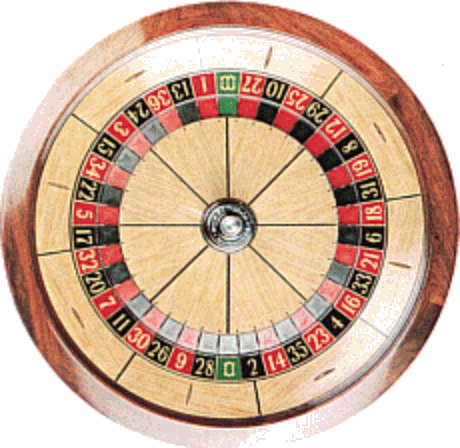
The betting layout in American casinos looks like this:
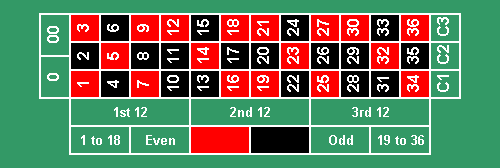
The columns, labeled here as C1, C2, and C3, are usually labeled as "2 to 1" on the actual casino tables. They are labeled here as column 1, 2, and 3 for simplicity and to help make the text fit. There are two types of bets: Inside Bets and Outside Bets.
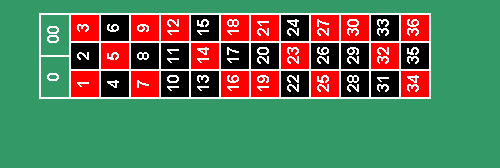
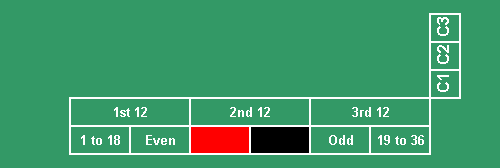
Every casino has its own "currency" in the form of "casino chips". Casino chips are treated as cash inside the casino. In fact, the casino chips at one time were interchangeable from casino to casino within a given geographical area. Today, many casinos will still honor chips from nearby casinos, but because of counterfeiting they may be reluctant to do so and in some cases, may refuse to. Therefore, it is a good idea to exchange your casino chips for cash when moving from casino to casino. Casino chips are colored, typically with each color representing a particular value. In addition to coloring, they will also have value indicators such as $5, $25, $100, etc, as well. Many casinos typically use white for $1, red for $5, green for $25, and black for $100. However, there is nothing that says the chips must be of any certain color and each casino is free to chose its own coloring scheme. Therefore, you should look for the value indicators printed on the chip inserts.

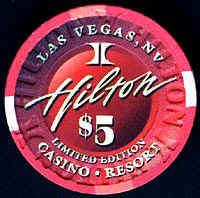
At the roulette table, you can of course use casino chips directly for betting. Simply place them on the number or region you are betting on during the time that bets are open. However, since everyone at the table is sharing the same area to place bets, it can get very confusing as to who a particular bet or chip
belongs to. This can lead to arguments and disputes over payoffs. To resolve this, the game of roulette has what is called "Roulette Chips". Unlike their "Casino Chip" counterpart, a roulette chip has NO value. This means that if you leave the roulette table with the roulette chips, they are worthless away from the table and you will lose whatever amount you spent in getting the chips. Therefore, you should always cash in your roulette chips for the equivalent casino chips before leaving the roulette table. By now you are probably wondering that if these roulette chips have "no value" then how do you convert from cash or casino chips to/from
these chips. The answer is that the value is assigned by the player. There are typically 6 or 7 different colors of roulette chips at a given table. Each player receives a unique color -- unique from all the other players currently playing. This eliminates the dispute as to who a certain chip belongs to. When you sit
down at the roulette table, you can pick out a chip color from the chips not in use by other players. You then trade in either casino chips or cash for the roulette chips. Each roulette table and/or casino will have a "unit value" established as a minimum for the chips. This varies from
casino to casino and is always posted at or near the table -- so look for it before sitting down at the table. In smaller casinos, you'll see minimum unit sizes like $0.25 and $0.50. The larger and more prestigious casinos may have minimum units of $1, $5, or even $10. Typically you can assign your chip
values to be any standard multiple of the minimum value. For example, if the table is a 25 cent table, then the minimum chip value is 25 cents. You can get chips worth 25 cents,
50 cents, $1, $5, etc. Anything that is a "standard" multiple of the minimum value. In addition to casino chips and roulette chips, most all casinos will allow you to place bets with regular money. But this is often limited to outside bets due to space restrictions in the inside area. Some
casinos, however, may insist that you exchange your regular money for chips. If in doubt, ask.
Before you leave the roulette table, simply ask the table operator to cash in your roulette chips. He will take and count your chips and give you the equivalent in casino chips. The casino chips can be used again at the roulette table (or other table games) or you can take them to "the cage" or cashier and exchange them for cash. But,
Don't leave the table with the roulette chips!
You may be wondering how the table operator remembers how much your chip is worth with so many people playing, or how when table operators are changed the new operator knows what they are worth. The answer is that when you purchase the roulette chips, the operator will place one of your chips in a special rack near the
roulette wheel along with a marker. The marker will indicate to the operator how much that color chip is worth. Typically, the markers will be a number that tells them how much a "stack" of chips is worth. A stack of chips, in most all casinos is 20 chips. Therefore, if you get 50 cent chips, the marker will
probably be the number 10 -- meaning one stack is worth $10. Similarly if you get $1 chips, the marker would be 20. For $5 chips, it would be 100, etc. Usually if you are betting with the table unit size chip, no marker will be used. I always make it a habit of checking the marker that they place for my chip
to make sure that it is indeed correct. As it would be easy for them to forget to either place a marker or to place the wrong one. This could lead to a dispute when you cash out and possibly cause you to get short changed -- so look for your marker value.
Another point worth mentioning is that most casinos prefer you buy chips in "stacks" of 20. So just go along with it. If you decide you don't want to bet with that much, you can just hang onto the extra chips and cash them back in when you are done. For a 25 cent table, a stack of unit chips would only cost $5. Typically at a 25 cent table, since the outside minimum is typically 4 units and inside minimum is 5 units (see minimum and maximum bets below), I prefer to use 50 cent chips as it is less counting and easier to keep up with. I also like to keep my chips stacked into groups of 20 so that it is easy to quickly count and see how much "money" I have on the table. Plus it is easier and quicker to cashout if you already have the chips separated into the stacks of 20. This is because the casino is going to count, stack, and separate them out into stacks of 20 anyway. If you give them the chips already in stacks of 20, all they have to do is to count one stack and make sure there are 20 there and then check to make sure that all of the other stacks are the same height.
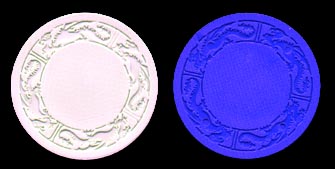
So now you are sitting at the table. You have your roulette chips in front of you. You are ready to start betting, right? Wrong! Before you can start betting, you need to check the sign at the table and see what the minimum and maximum bet values are. These are often related to the
minimum chip values. For example, the inside bets may have a minimum of 5 units and the outside bets have a minimum of 4 units. Therefore, if the table is a 25 cent table, a typical inside minimum would be $1.25 and a typical outside minimum would be $1. However, this can vary from table to table
and from casino to casino. Another thing to be aware of is to understand what is considered a "bet". Often an "inside bet" can be distributed over any of the possible inside bet configurations (see inside bets below). The "outside bets", on the other hand,
are typically considered to be within a single outside bet square. What this means, using the current example, is that the $1.25 minimum inside bet can be distributed among any of the inside bet configurations. That is, you could bet 25 cents on the number 21, 25 cents on 13, 25 cents on the 33/34 split, and 50 cents on the 1/2/3 street
(see inside bets below). The only requirement is that the total of the chips must add up to the inside minimum -- you don't have to place the minimum entirely on one single betting configuration. Outside bets, however, are usually considered to be independent. That is, if you want to bet on "odd"
you must place at least the outside minimum in the odd square. If you want to bet on both odd and black, you must place the minimum outside bet amount in BOTH the black and the odd -- in this example, that would amount to $2 or $1 for each. Again, this may vary from table to table so ask if you aren't sure. Also,
note that the outside and inside are treated as being separate. That means if you want to place both an inside bet and an outside bet, then your inside bet must add up to the inside minimum and your outside bets must each be the outside minimum. Thus if the inside minimum is $1.25 and the outside minimum is
$1, you can't just put $1 on the outside and $0.25 on the inside. Instead, you would have to place $1.25 on the inside in addition to your $1 on the outside.
The other limit is the maximum bet. This works pretty much the same as the minimum bet, but dictates the maximum amount that you can bet either inside or outside. Why have a maximum? Well, if it weren't for the maximum bet size, it is possible to use several of the well known Winning Systems to
always be a winner -- and the casino isn't going to allow that. Once you have become familiar with the game of roulette, read the section on Winning Systems where we will discuss many of the common systems as well as develop our own system of play.
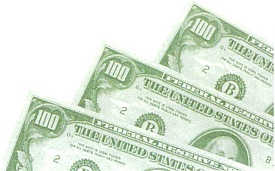
When the table is "idle", the number portion of the wheel is slowly spinning and the marble is resting in the last number slot that it landed in. At this point, you can buy chips, cash out your chips, or start making bets for the next spin. So go ahead and place your bet. If you want to bet
on a spot that someone else has already bet on, simply place your bet on top of his. Since you are using different colored chips, it will be easy to tell who the owner of the chips are. After the operator has finished all transactions,
he will spin the marble in the outer race of the wheel. Even during this time, you can continue to place bets. You can continue to place bets until the ball starts to slow, several revolutions from entering a pocket on the wheel, at which time the operator will call "no more bets" and sweep his hand across the
table. If you continue to try and place bets after the operator has called "no more bets", the operator can reject your bet. Also, attempting to place bets after the marble has landed in a slot on the wheel is a sure way to get kicked out of the casino. Such an attempt is called "past-posting" and
is strictly prohibited and for good reason.
Once the marble has landed into a slot on the wheel, the operator will place a marker, called a "win marker", on the table directly on top of the winning number. The operator will then remove all losing bets from the table and then payout all of the winners (if there are any). Payouts are done in a
pre-determined order, with the outside bets being paid first followed by the inside. While the "win marker" is on the table, you are not allowed to remove any of your winnings or place any new bets. Doing so will cause you to be reprimanded by the operator. After finishing the payouts, the win marker is
removed and you are free to remove your winnings and/or place new bets. Note that your original bet, if it wins, is left on the table. On the outside bets, the payoff is usually placed there along side the original bet. The inside bets are usually paid off by sliding the payoff chips to the winning player. However,
note that the original bet, even on the inside bets, is left on the table. Therefore, unless you want to keep the bet there for the next spin, be sure to remove it.
Another note for placing bets is to be certain that you place your bets correctly. For example, if you are placing a straight-up bet on a number be certain that the chip is placed entirely inside the lines. If the chip is touching the lines, it will be interpreted as either a split or corner bet and you will receive
less than your expected winnings. It is also a good idea to carefully watch the operator as he is collecting losing bets, as he may accidentally remove a bet that is really a winning bet. Also, count your payout to make sure the operator didn't make a mistake in
counting out your winnings.

There are 6 different configurations for the Inside Bets. These 6, in order, are called: Straight-Up (single number), Split (two numbers), Street (three numbers), Corner (four numbers), Sucker (five numbers), and Line (six numbers). Below we will examine each of these six configurations. Each will include several examples of how to place the bet. Remember that you can place any combination of these inside bets and that the sum of the bets together must add up to be at least the required inside minimum.
Straight-Up bets are bets on individual numbers and is one of the easiest to keep up with. You simply bet on one of the 38 numbers. If that number comes up, you win. If it doesn't you lose. Straight-Up bets are made by placing one or more chips directly on top of the number on the betting
layout. Here are some examples:
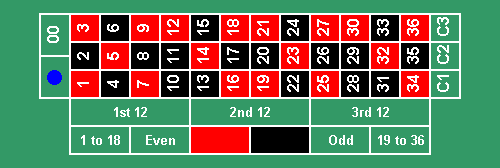
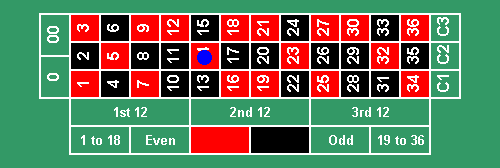

Take note that the chips are placed entirely inside the square and not touching any line. If a chip is touching a line, it will be interpreted as a different type of bet.
Straight-up bets pay 35 to 1. And there are 38 unique straight-up bets that can be made (one on each number).
Split bets are bets on two adjacent numbers on the table and can be placed anywhere there are two numbers that are separated by a single line. On split bets, if either of the two numbers bet on comes up, you win. Mathematically speaking, placing two chips on a split is totally the same as placing two single chips, one each
on the two numbers of the split. The same applies to all of the other bets (with the exception of the sucker bet), so we will illustrate it here and not continue to do so for each example. The payout on a split is 17 to 1, as opposed to 35 to 1 on a single number. Remember that in addition to the payout, you
keep your original bet. Thus, if you place 2 chips on a split and one of the 2 numbers comes up, then you get paid 17 chips for EACH of your two, or 34 chips total. Plus you keep your original 2 chips giving you 36 chips. Similarly if you place 1 chip straight-up on each of the two numbers and one of the two comes up, you
will automatically lose one of the two chips (as it was a losing bet), but you keep the chip that was on the winning number. For that winning chip, you'll be paid 35 additional chips giving you again a total of 36 chips. What the betting methods allow you to do is to bet less chips on the combination of numbers than you normally
would have to on the equivalent straight-up bets. For example, you can bet a single chip on a corner (or 4 number bet) and if any of those 4 numbers comes up, you win 8 additional chips (see corner bets below). You could have easily placed a single chip on all four numbers, but then you'd be wagering more money per
spin, though by doing so you also win more when one of the numbers does come up. Anyway, here are some examples of split bets:
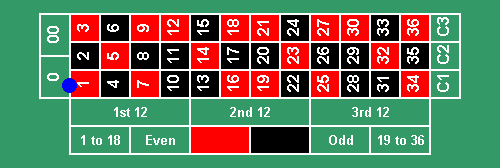

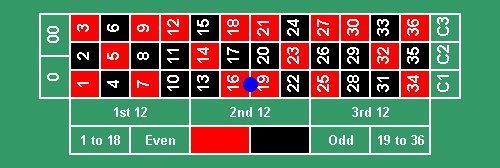
There is one special split bet on the table that on many layouts, including this one, isn't marked. However, most all roulette operators will accept it. It is called the "zero bet" and it is done by placing one or more chips on the line that separates the 2nd 12 and 3rd 12 groups on the outside. It looks much like an outside bet, but
since outside bets cannot be split it is really an inside bet. This bet is entirely equivalent to placing the same number of chips on the line that separates the 0 and the 00. Note that this has no meaning on the European wheel which only has a single zero. This special 0/00 split bet looks like this:
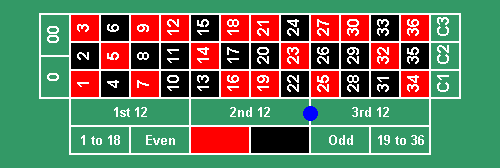
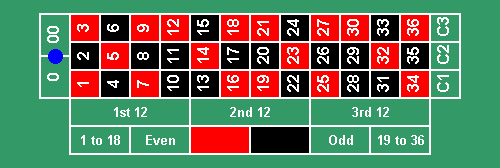
Split bets pay 17 to 1. And there are 62 unique split bets that can be made.
A Street bet is a group of 3 numbers that can be bet on. The name comes from the way that the rows of 3 numbers look like "streets". Bets on rows of three numbers are made by placing a chip on the line that separates the first number of a row of 3 from the outside betting area. Additionally, there are 3 additional
places that you can make a three number bet, because of the 0 and 00. You can also put a chip on the intersection of 0-2-00, or 0-1-2, or 00-2-3. These special ones don't really form "streets", but they are groups of 3 numbers and hence have the same payout. On the European wheel, since there is only a single zero,
you would only have 2 of these special groups, namely 0-1-2 and 0-2-3. The examples below show 2 normal street bets and one of the special 3 number bets:
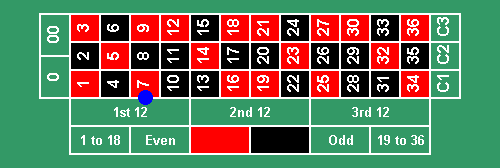

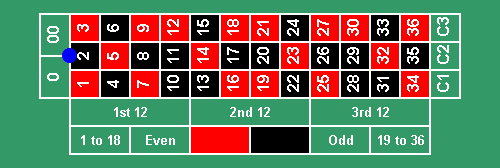
Street bets pay 11 to 1. And there are 15 unique street bets that can be made.
A Corner bet can be placed anywhere a "corner" is formed from where 4 numbers come to together. Simply place a chip on the corner where all the lines from the four numbers intersect. For some reason, this is one of the most popular bets on the roulette table, but no one knows why. Here are several
examples of corner bets:
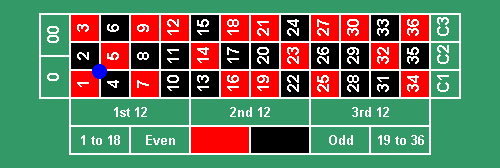
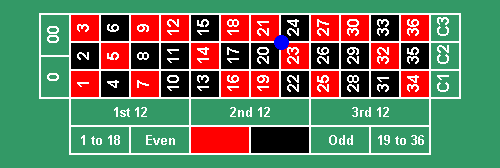
Corner bets pay 8 to 1. And there are 22 unique corner bets that can be made.
The Sucker bet is a five number bet. It looks a whole lots like the Line or Six number bet that we'll discuss next. However, it only covers Five numbers. There is only one possible Sucker bet and it covers 0-00-1-2-3. The reason it is a sucker bet is because the payout ratio is less than all other configurations. Ideally
this bet would pay 6.2 to 1 since 5 doesn't divide evenly into 36. But, casinos don't want to bother with the odd payout ratio, so this bet only pays 6 to 1. This causes the house advantage on this bet to increase to 7.90% instead of the 5.26% on all other bets. This is the only one that the payout on this bet doesn't equal the equivalent
payout on betting the numbers straight-up, as discussed in the split bet section above. For example, if you bet 5 chips on this sucker bet and any of the 5 numbers hits, you'll be paid 30 chips plus you keep your original 5 -- giving you 35 chips. However, if you were to place a single chip straight-up on each of the same 5 numbers
and one of the 5 hits, you'd win 35 chips plus you'd keep the chip on the winning number giving you 36 chips. So you can see that you are losing one extra chip out of every 36, which is why this is a sucker bet. Instead of betting the sucker bet, I recommend something like a 1-2-3 street and a 0-00 split. Avoid the sucker bet. Note that on
the European wheel that only has a single zero, there is no sucker bet. On that table configuration, you can place a bet at the same spot as with the sucker bet, but there you are betting on 4 numbers instead of 5 so it pays 8 to 1 as does a corner bet. Making it a fair bet on the single zero wheel. Here is the only possible way of placing the sucker
bet:
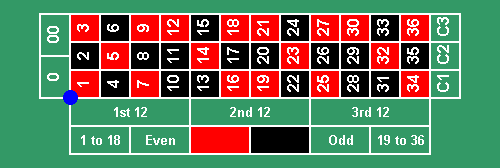
The Sucker bet pays 6 to 1. And there is only 1 way that can be made.
A Line bet is placed by putting one or more chips on the "line" that separates two streets -- hence, the name "Line Bet". It is the same as betting on two adjacent streets, which is why it is also called the "double street bet", and thus covers 6 numbers. Here are several examples of Line bets:
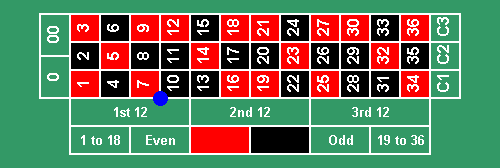
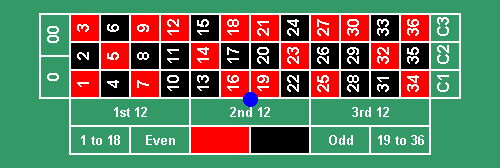
Line bets pay 5 to 1. And there are 11 unique line bets that can be made.
There are 5 different configurations for the Outside Bets. These 5, in order, are called: Column (12 numbers), Dozen (12 numbers), Red or Black (18 numbers), Odd or Even (18 numbers), and Low or High (18 numbers). Below we will examine each of these five configurations. Each will include
several examples of how to place the bet. Remember that you can place any combination of these outside bets, but, unlike the inside bets, each outside bet must be at least equal to the outside minimum.
In Europe, there are several additional rules on the even money outside bets (Red/Black, Odd/Even, and Low/High) that under certain circumstances allows you to lose only half of your money when an even money bet loses. However, this doesn't apply on the American wheel and so it will not be covered on this site. If you are planning to gamble in Europe, then I recommend getting
a book that explains the differences between the American and European systems (See the Book List for several).
A Column bet is made by placing one or more chips in one of the outside column squares. On this layout, the column squares are labeled as C1, C2, and C3, but on a real table layout, they are typically labeled "2 to 1". Placing a bet in a column is the betting on the 12 numbers that are depicted in that column. For example, placing a chip in C3
covers 3, 6, 9, 12, 15, 18, 21, 24, 27, 30, 33, and 36. Note that NONE of columns include the 0 or 00. Similarly, no outside bet
includes 0 or 00 either. Here is an example of a column bet:
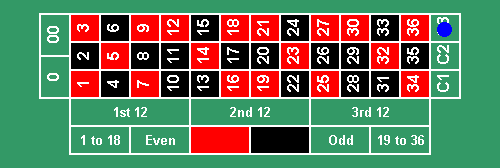
The Column bet pays 2 to 1. And there are 3 ways that it can be made.
A Dozen bet is very similar to the column bet except that instead of covering a column of numbers on the table, it covers either the 1st, 2nd, or 3rd consecutive group of 12 numbers. That is the 1st 12 would cover 1-12, the 2nd 12 would cover 13-24, and the last 12 would cover 25-36. Again, 0 and 00 aren't covered and are automatic losers. Here is an
example of a dozen bet:
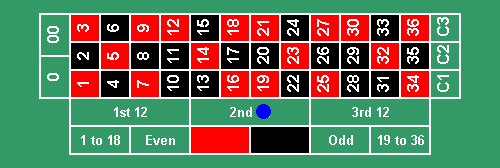
The Dozen bet pays 2 to 1. And there are 3 ways that it can
be made.
A Red or Black bet is an even money bet that wagers on the color of the next number to appear. Half of the numbers 1-36 on the wheel are red and the other half is black, and they are distributed around the wheel in an alternating fashion. Therefore, it is almost a 50/50 chance. However, it isn't quite 50/50 because 0 and 00 are green and don't count as either red or
black. The bet is made by placing one or more chips into one of the colored squares in the outside area. Here is an example:
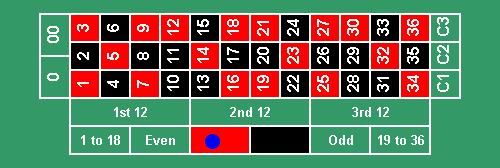
The Red or Black bet pays 1 to 1. And there are 2 ways that it can be made.
An Odd or Even bet is an even money bet that wagers on whether the next number to appear will be an odd number or even number. Note that half of the numbers from 1 to 36 are even and the other half is odd, and they too are evenly distributed around the wheel. So this is almost a 50/50 chance as well. However, the 0 and 00 don't count as even or odd, so it isn't quite 50/50. The bet is made by placing one or more chips
into either the square marked "even" or the square marked "odd". Here is an example:
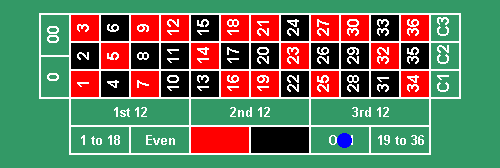
The Odd or Even bet pays 1 to 1. And there are 2 ways that it can be made.
A Low or High bet is an even money bet that wagers on whether the next number to appear will be a low number (1-18) or high number (19-36). Again half the numbers 1-36 are low and half are high, and the lows and highs are evenly distributed on the wheel. 0 and 00 don't count as either low or high and are automatic losers. A low or high bet is made by placing one or more chips
into either the square marked "1-18" for low or the square marked "19-36" for high. Here is an example:
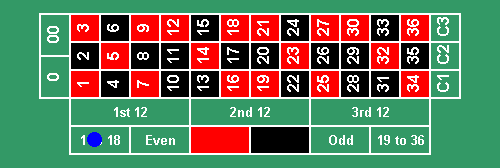
The Low or High bet pays 1 to 1. And there are 2 ways that it can be made.
As was noted in the introduction, even when you win, you lose. This comes about because you are betting on 38 numbers (1-36, 0, and 00), but, you are only being paid for 36. Therefore the 0 and 00 represent the house advantage which is 2/38 or 5.26%.
It is good to memorize all of the payout amounts so that you can verify that you get paid correctly each time you win. If you are having trouble memorizing how much each payout amount is, here is an easy way. Remember that you are only being paid for the 36 red and black numbers on the wheel. And remember that you keep your original bet amount when you win, which factors in as
part of the 36 numbers you are paid for. With that information, you can find the payout amount by dividing the number of numbers being paid on (36) by the number of numbers you are betting on (n). In the case of the sucker bet, you'll get an a fractional answer so round it down (which is why it is a sucker bet). Then subtract one (1) from the result since you keep your original bet amount. And what you have left is the
payout for the bet. Here is an example: Suppose you make a corner bet -- which is 4 numbers. Divide 36 by 4 and you'll get 9. Subtract 1 and you'll have 8. Thus a corner bet pays 8 to 1. Here is a table with all of them:
| Bet | Numbers in Bet (n) | (36 / n) | (36/n)-1 | Payout |
| Straight-Up | 1 | 36 | 35 | 35 to 1 |
| Split | 2 | 18 | 17 | 17 to 1 |
| Street | 3 | 12 | 11 | 11 to 1 |
| Corner | 4 | 9 | 8 | 8 to 1 |
| Sucker | 5 | 7.2 | 6 | 6 to 1 |
| Line | 6 | 6 | 5 | 5 to 1 |
| Column or Dozen | 12 | 3 | 2 | 2 to 1 |
| Even Money | 18 | 2 | 1 | 1 to 1 |
Since you are paid on only 36 of the 38 numbers, it would make no sense to bet on everything or even everything in a group, unless of course you are just there to drink "free drinks". If you were to bet on all 38 numbers straight-up, then 37 will automatically lose and you'll be paid 35 to 1 for the one that hits. So every time the ball spins you'll automatically lose the
chips on two of the squares. Similarly if you bet on all of the bets in a group, such as all three columns, you'll always break even unless a 0 or 00 comes up and then you'll lose all three. So, if you are just wanting to sit there and drink "free drinks", then you could bet, for example, on both red and black and you'll always break even unless the 0 or 00 come up. If you are lucky, they won't
come up at all or only once or twice -- and hey, what is a dollar or two for a dozen "free drinks"?
One of my favorites, especially while doing wheel clocking, etc (see Winning Systems), is to bet on 2 columns (or dozens) simultaneously. Obviously, one of the two will definitely lose, but since they pay 2 to 1, you have about a 63% chance of making the amount that you place
on each column, which means you have better than a 50/50 chance of choosing one of the winning columns or dozens -- which isn't bad.
The important thing is that you have fun. Expect to lose all of the money you bring to gamble with, but be prepared to win. Most importantly, stop while you are ahead as that is the only way you'll win. With the 5.26% house advantage, in the long run, unless you can find a way to predict the numbers, the house will always come out ahead.
The section on Winning Systems will explain several way of beating the house through smart, well placed bets. However, if you've never played roulette before, I highly recommend sitting some money aside and go down to the casino and just play for a while. Watch how other people bet; watch how the game flows, and remember what you
have read here. Place small bets and get familiar and comfortable with the game. It is necessary to be comfortable with the overall process before trying to implement any system. After you have a full understanding of the game, study up on system play. Read my section on Winning Systems and read other books and sources on winning
systems. Some book information can be found on my site. But also do some searches on the net as there are many many others. Do use a system, because playing without a mathematically sound system is foolish.
Beware of people that sell systems that supposedly work. My question to them is if their system works so good, why don't they just give the system away and make their money by using the system in a casino? There is one system I found online
that claims it is guaranteed and that they will even fly to the casino and help you learn it, all with a full money-back guarantee. I'm thinking about trying to bargain with them that if they meet me in a casino, show me the system, and if I win enough money there to cover the cost of the system and their trip, that money is theirs and I'll have the system. And if it doesn't work, then I will automatically have my "money-back
guarantee" taken care of. They sell this system for $1250, plus shipping, but I think the only way I would buy it is if they will, as I said, meet me in a casino and show me exactly how to win the money that will pay for the system itself. It will be interesting to see if they take me up on the offer.
Have Fun! And Good Luck Gambling!
Check out the Glossary.